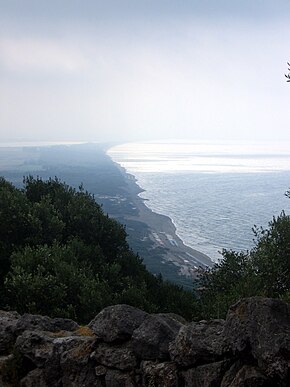Cosa

Vulci's coast, seen from Cosa
|
|
| Location | Ansedonia, Italy |
|---|---|
| Region | Province of Grosseto |
| Coordinates | 42°24′39.3078″N 11°17′11.4102″E / 42.410918833°N 11.286502833°E |
| Type | Settlement |
| History | |
| Founded | 273 BC |
| Abandoned | after AD 1329 |
| Periods | Roman Republic, Roman Empire |
| Cultures | Ancient Rome |
| Site notes | |
| Excavation dates | 1948–54, 1965–72, 1990s, 2010s |
| Archaeologists | Frank E. Brown, Lisa Fentress |
| Condition | ruined |
| Public access | yes |
| Website | Ansedonia - Città di Cosa; Museo Archeologico Nazionale di Cosa (Italian) |
Coordinates: 42°24′39″N 11°17′11″E / 42.410919°N 11.286503°E
Cosa was a Latin colony founded in southwestern Tuscany in 273 BC, on land confiscated from the Etruscans, to solidify the control of the Romans and offer the Republic a protected port. The Etruscan site (called Cusi or Cosia) may have been where modern Orbetello stands; a fortification wall in polygonal masonry at Orbetello's lagoon may be in phase with the walls of Cosa. The position of Cosa is distinct, rising some 113 metres above sea level and is sited 140 km northwest of Rome on the Tyrrhenian Sea coast, on a hill near the small town of Ansedonia. The town experienced a hard life and was never truly a prosperous Roman city, although it has assumed a position of prominence in Roman archaeology owing to the circumstances of its excavation (cf. Dyson 2005, below). After the foundation, wars of the 3rd century BC affected the town. New colonists arrived in 197 BC. Cosa seems to have prospered until it was sacked in the 60s BC, perhaps by pirates - although an earthquake and unrest related to the Catilinarian Conspiracy have also been cited as reasons. This led to a re-foundation under Augustus and then life continued until the 3rd century. One of the last textual references to Cosa comes from the work of Rutilius Claudius Namatianus in his De reditu suo. In the passage 1.285-90, Rutilius remarks that by AD 416 the site of Cosa was deserted and could be seen to be in ruins. He further suggests that a plague of mice had driven the people of Cosa away.
...
Wikipedia

